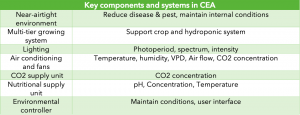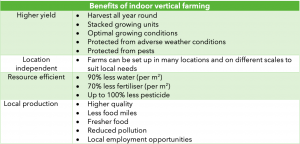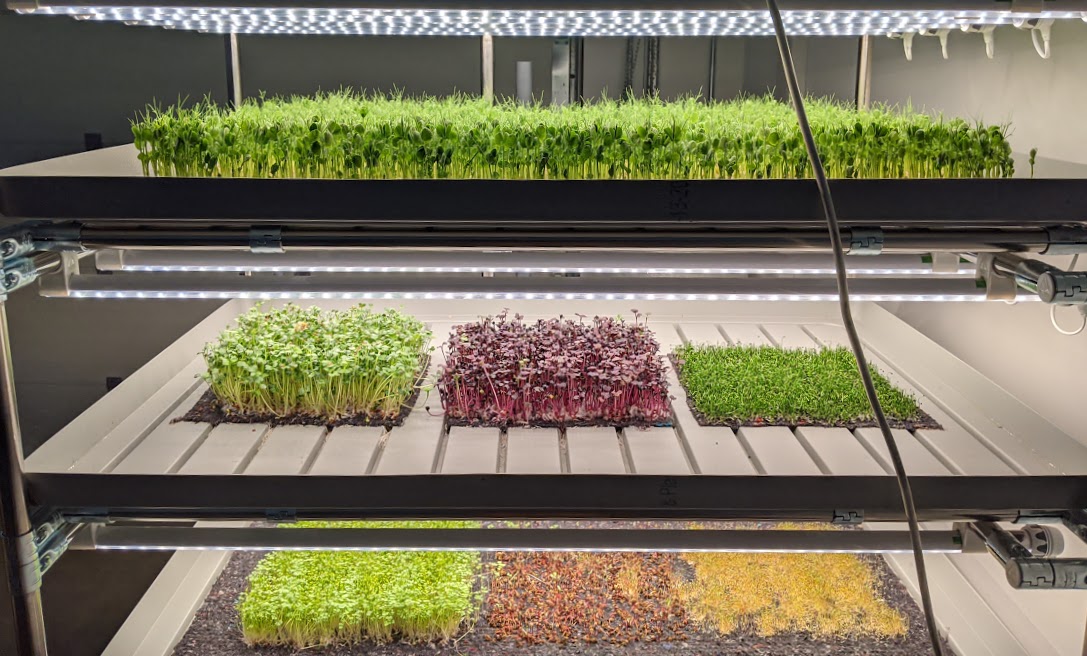The food system is complex and faces various inter-related issues around climate change, energy use and production capacity. Here, we discuss the potential solutions we have for dealing with these issues to ensure we maintain food security this century.
Food groups
Food can broadly be divided into four categories, animal, fish, mushroom, and plant, and are sold fresh, frozen, or processed into other products. Types of plant-food can be further separated into staple and functional plants.
Staple crops
There is massive global demand for staple crops, such as cereals. To meet this demand, huge quantities of resources are input into open-field systems including land, water, pesticides, fertiliser, energy, and CO2. The resource intensity and required scale for sufficient production of staple crops means industrial open-field methods will remain the dominant production method. Innovations in land management, crop breeding and the emergence of robotics can be used to decrease input and increase output in these systems.
Functional crops
Vegetables, fruits, herbs, medicinal plants, and mushrooms are examples of functional foods. These foods are in high demand; the UK imported 2.1 billion tonnes of vegetables and 3.2 billion tonnes of fruit in 2020.
Plants used as functional foods typically need a specific environment to grow optimally. The production of valuable crops is concentrated in areas with favourable climates, however one third of the countries exporting to the U.K are considered climate vulnerable. This poses a risk because any factor that affects production or distribution sharply reduces the availability, driving up its price and causing shortages
Fresh functional foods are highly perishable because they have a high-water content (>90%). Long-distance, petrochemical-based transportation with cooling is required because production centres may be hundreds or even thousands of miles from the point of consumption. To extend shelf life, crops are also harvested early, reducing overall quality. The resource-intensive refrigerated transportation needed to move fresh food over long distances contributes to the food system’s impact on the environment.
Although there is high demand for these functional foods the supply chain is vulnerable and can harm the environment and the length of the supply chain also lowers product quality. One solution is to use indoor vertical farming to produce these foods in urban environments, areas which otherwise most reliant on imports.
Indoor vertical farming explained
Indoor vertical farming is the practice of growing plants inside warehouses or rooms and in enclosed chambers. Plants are grown in shelves, stacking up vertically with each shelf illuminated by LEDs. Soilless growing techniques are frequently used because they require fewer resources and are simple to use.
A key component of vertical farming is environmental control, for plants to grow optimally the environment must be ideal. Controlled environment agriculture (CEA) techniques are used to maintain consistent temperatures that can be tailored to the needs of the plant. Key components and systems are listed in the table below.

Benefits
Growing functional plants using indoor vertical farming and CEA has major benefits:

Obstacles
Indoor farming is conducted on a significantly smaller scale than open-field agriculture, limiting the applicability vertical farming and hydroponics methods to certain crops. Vertical racks are typically spaced 40 cm apart, crops are grown in high densities and low-intensity light. This is unsuitable for crops with low value per kg, but crops suited to these conditions and with a high value per kg, such as herbs, can be grown and sold economically.
Indoor vertical farms are costly to set-up, ranging from £1000 to £2250 per square meter depending on size and level of automation. Operational costs can also be high as indoor farms are energy intensive, with energy representing 25% of costs. Another significant expense is labour, which can contribute up to 30% of operational cost.
Many of the obstacles can be overcome by using automation for tasks and environmental control. Artificial intelligence and machine learning can reveal processes or conditions that maintain desired output while reducing inputs. Agxio are actively investigating potential applications of their AI engine Apollo, through the CEA platform Ceres. Click here to find out more. The significant amount of commercial interest in indoor farming will result in innovation and improvement of practices, driving costs down
Outlook
Indoor vertical farms can’t replace open-field agricultural production but can support the local production of functional crops. These in-demand crops are otherwise reliant on a long food-chain that damages the environment, is resource intensive and reduces quality for the end user. There is need for improvement in indoor vertical farming practices, the benefits make it a solution worth pursuing.
By Ben Butler, Controlled Environments Specialist at Agxio



